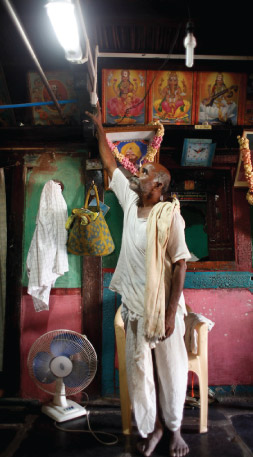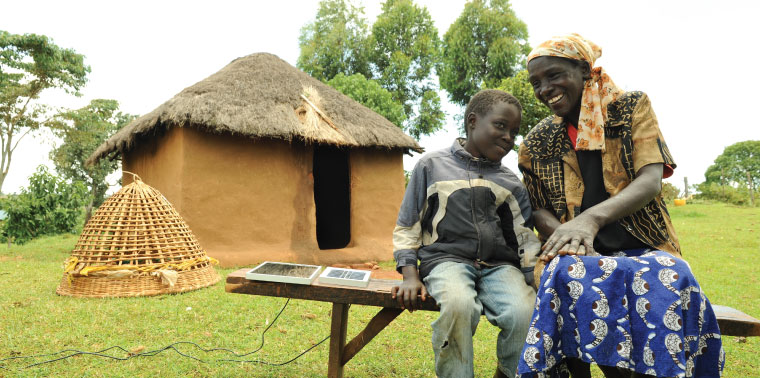Beyond small lanterns, larger household photovoltaic systems can power a range of items: more lights, ceiling fans or a television. At an even larger scale, mini-grids—some fueled by solar, but others by biomass or wind—are emerging as new nodes of power to serve areas of 10 or fewer kilometers across that are off the main grid or that have spotty service. And a few locations, such as Burkina Faso and Ghana, are installing large-scale solar systems linked to the grid, says Stephen Gitonga, energy policy advisor to the United Nations Development Programme.
Direct Use
Of course, photovoltaics aren’t the only way to capture the sun’s energy. The sun can be put to direct use as well to replace conventional energy sources that have downsides for human health and the environment.
Solar cooking, for example, reduces smoky indoor fires and the need to gather firewood for cooking, which can contribute to deforestation and put women and children in dangerous situations. However, solar cookers have found only limited use in developing areas.
“Solar cookers are unlikely to be more than a bit player because they require significant changes in cooking habits,” Jacobson says. Users have to cook outside the house and during daylight hours, for example. For these reasons, they may work better for institutions, such as schools or temples, rather than in homes, some experts say.
“Mobile banking and microfinancing—those two things combined are making for some interesting possibilities that weren’t really there just four years ago.”
Still, Patricia McArdle, a long-term member and former board member of Solar Cookers International, thinks more needs to be done to expand the use of solar cooking. “What’s different now is the population is on its way to 9 billion,” she says. “A tree takes 30 years to grow. It takes less than a month to burn in a cooking fire.”
While solar cookers have faced roadblocks, solar water heaters—often arrays of water-filled tubes that heat water directly by soaking up the sun’s rays—are highly efficient and particularly common in cities. Kathmandu, Nepal, for example, has them on nearly every roof, Gitonga notes, while Bangalore, India, has a law requiring that all new construction above a certain size have solar water heating.
“In the case of water heating, it’s just really a straight economic payback where people are using diesel,” says Damian Miller, CEO of Orb Energy, an India-based solar company. Their fast payback has made solar water heaters Orb’s best-selling product.
Overcoming Challenges
The expansion of solar in developing countries has faced challenges at all levels, including governmental, where import tariffs and kerosene subsidies can work against it, and cultural, where technologies sometimes don’t mesh with the way people actually live. Still, many start-up companies, looking to capitalize on an enormous potential market while improving lives, are trying to address these and other challenges—especially distribution, reliability and financing.

A man lights a room with the flip of a switch thanks to a solar system from Orb Energy, a company that designs and installs solar photovoltaic and solar water-heating systems in rural markets throughout India. Photo courtesy of Orb Energy.
One of the key challenges is the “uphill battle of small firms making good products against massive ‘bottom-feeding’ manufacturers dumping shoddy products into the market by the container-load,” says Evan Mills, an energy expert at the Lawrence Berkeley National Laboratory in Berkeley, Calif. D.light’s Tozun agrees: “We go into markets all the time where people … have had a bad experience [with solar]. We are being fanatical about making our products extremely rugged and affordable.”
Lighting Africa and its newer sister organization, Lighting Asia, programs led by the International Finance Corporation, offer product testing and a set of criteria to ensure quality in small devices such as portable lamps. These include making sure a lamp actually delivers the amount of light and battery life claimed on the package and testing whether a product can survive being dropped. They also require a minimum of a six-month warranty. Jacobson, who is the technical lead for the program, says it is beginning to have an effect. Lighting Africa–certified products—40 so far—are gaining market share, with annual sales growing threefold in the past four years.
While reliability is important to encouraging use of any product, so is affordability.
“Mobile banking and microfinancing—those two things combined are making for some interesting possibilities that weren’t really there just four years ago,” Jacobson says. Microfinancing gives small loans to households or businesses, which is a good option for some consumers. But lenders can still be slow and risk averse, and many potential buyers have irregular income streams that make a loan with regular repayment, however small, an intractable option. Paul Needham, founder and president of Simpa Networks, which sells energy technology in India using a “progressive purchase” model, draws an analogy once again to cell phones. While cost declines made it easier for people to afford phones, he says, “the biggest innovation is the prepaid, pay-as-you-go pricing. That allowed companies to serve people who don’t have credit histories.”
Ensia shares solutions-focused stories free of charge through our online magazine and partner media. That means audiences around the world have ready access to stories that can — and do — help them shape a better future. If you value our work, please show your support today.
Yes, I'll support Ensia!

For those who'd like to learn more about, and get involved in bringing solar to low-income villagers in developing countries, I compiled relevant resources here:
http://bennu-solar.com/
Hope this helps,
Yotam
(http://www.linkedin.com/in/yotamariel)
WakaWakaLight discovered at a field survey in Northern Nigeria that families did spend 2.5 hours extra every day thanks to their newly acquired solar LED lamp.
Moreover, it is a major step in combatting the forgotten routine horror of heavy poisoning by the suffocating air pollution from toxic kerosene fumes and the 300,000 yearly death victims by burning accidents AND the 6,000,000 severely burned victimes.
This 'silent drama', unfolding e-v-e-ry day, 365 days e-v-e-r-y year has to be stopped.
And it CAN be stopped.
With our solar LED lamp and its 'brother', that also can charge power driven devices like mobile phones, radio's, MP's players and tablets, we hope to contribute to ending this horror, to help escape 'killer kerosene' and to enable also people to build a better future for themselves.
More info: www.wakawakalight.com and www.wakawakafoundation.org
I think that fact alone--having a cell phone but not light--is astonishing. More importantly, it also shows that dispersing solar powered devices with scale is possible in this decade. If cell phones can, then solar lights surely can too.
More info on how people anywhere in the world can invest in rural, off-grid solar projects: www.sunfunder.com
Your article is great. It can complement what we are doing right now. We are into disseminating simple overviews of solar technology for the understanding of the common layperson. Thus simplicity is the theme. Visit us at: http:wwwbuildsolar4betterlife.com